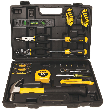Installing Energy Efficient Doors
Written by Lee Wyatt (last updated April 14, 2021)
If you find yourself faced with utility bill that is high year round, you may want to check your doors. Energy inefficient doors are a leading cause of high energy bills, particularly during the extreme weather months (winter and summer). One way to help combat those rising bills is by installing energy efficient doors. Luckily it's not particularly difficult, as long as you follow these directions.
- Measure your entry. These instructions assume that you have already removed the previous door from your entry way, and that all you have is an opening that needs to be closed. If you have not already removed the previous door, make sure that you do so now. Measure the open entry way diagonally so that you know what space you have to work with. Make sure that you measure the door opening from one corner to the other in a diagonal direction, as well as getting the height and width measurements. This way you can ensure you get the best possible opening for your entryway. Double check all measurements to ensure accuracy.
- Get your new door. Take the measurements you wrote down and go to your local home improvement store. Find a prehung energy efficient door among the selections which meet your measurements. When you are making your selection you will want to pay particular attention that your door is Energy Star rated (which will get you a federal tax credit), is certified by the National Fenstration Rating Council (NFRC), and has a high R-Value. R-Value is how insulation is measured, so the higher this rating the more efficient it is in preventing heat transfer.
- Get your help. Installing energy efficient doors can be a physically demanding project, so you need to have at least two people help you out. These two people can help hold the door in place while you are securing it, while also helping to make sure everything is level and plumb.
- Level out the opening. Before you begin hanging the door, you need to ensure that the entry hole is leveled and ready for the new door. Do this by holding a builders level against each side of the opening. If that side is not level, go ahead and make the adjustments as necessary to make it so. Typically this means it will be necessary to remove some material from each side of the opening.
- Place and shim as necessary. Place the new door (frame and all) in the middle of the opening. You will want to have the assembly as centered as possible to ensure that you get the best possible placement. With the door assembly being held in place, begin placing shims as necessary to ensure everything is evenly spaced, level, and held in place. Periodically check each side to ensure everything is level, and also open and close the door. Opening and closing the door will ensure that you haven't warped the assembly in any way.
- Trim the excess. With everything in place, all sides leveled, and the door able to open and close freely, you can begin trimming the excess. Be as careful as possible that you do not accidentally remove the shims.
- Nail it. When the shims are flush with the surrounding jambs and frame, double check to ensure everything is level. If it is not shim as necessary to ensure that the door is level again. With the door leveled, and shims flush, use finishing nails to hold the door in place. Use as many nails as necessary to ensure it is held in place, and make sure that you go through each shim to hold them in place.
Once you have finished nailing the doorframe into place do a quick double check. Basically you want to make sure that you have all the shims cut flush to the frame, and that the door is as plumb and level as possible. All that you have to do now is the final finishing. This is another project that you can do yourself, or that you hire a general handyman to do for you.
Author Bio
Lee Wyatt
Contributor of numerous Tips.Net articles, Lee Wyatt is quickly becoming a regular "Jack of all trades." He is currently an independent contractor specializing in writing and editing. Contact him today for all of your writing and editing needs! Click here to contact. Learn more about Lee...
Planting a Fall Hanging Basket
Whether you only have a little space, or are looking for an accent piece, planting a fall hanging basket can be a great ...
Discover More
Getting Motivated to Organize
Have you ever noticed how difficult it can be to get motivated about organizing? Sometimes organizing projects can seem ...
Discover More
Cheesy Potato Casserole
If you are looking for a really tasty and easy to make side dish that can go with just about any main dish, then you ...
Discover More
More Home Improvement Tips
Repairing a Strike Plate
Over time just about everything in your home will need to be repaired, even the little strike plate on your door. ...
Discover More
Weather Stripping Exterior Doors
Next time you get your energy bill, you might be surprised to find out how large it is. One way to combat this rising ...
Discover More
Installing a Hinged Patio Door
Patio doors are a great way to bring the great outdoors inside your home, and one of the most popular choices are hinged ...
Discover More

Comments